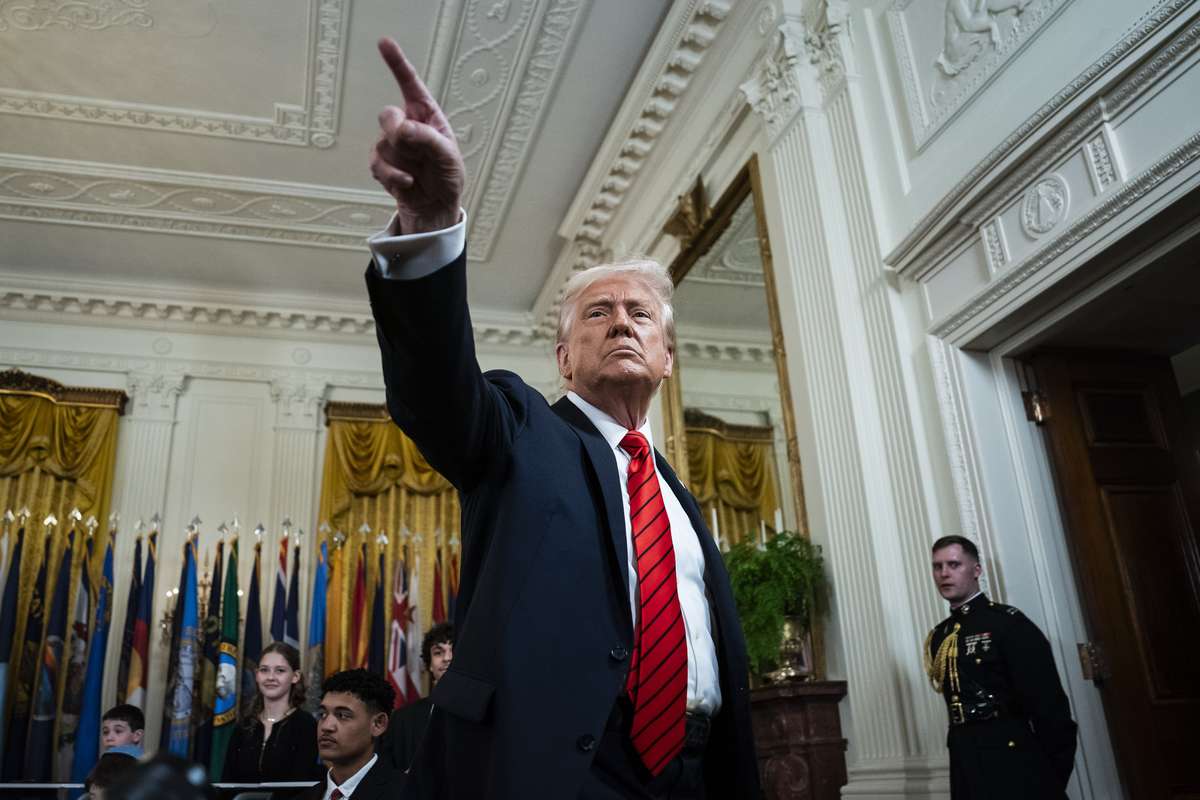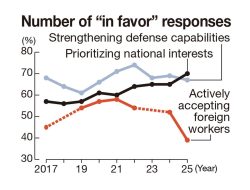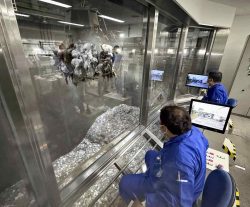Trump Escalates Global Trade War with New 25 Percent Automobile Tariffs

President Donald Trump greets guests during an event at the White House on March 20, 2025. The president announced new 25 percent tariffs on imported cars and auto parts on Wednesday.
13:22 JST, March 27, 2025
President Donald Trump on Wednesday announced plans to impose a 25 percent tariff on imported automobiles and auto parts, gambling that consumers will accept higher prices on cars today in return for the promise of regaining lost manufacturing jobs in the future.
Speaking in the Oval Office, the president said he was acting to encourage the return of auto manufacturing to the United States, predicting “tremendous growth” in the industry and enormous new tax revenue for the U.S. Treasury.
“We’ll effectively be charging a 25 percent tariff. But if you build your car in the United States, there is no tariff,” Trump told reporters.
Vehicles that meet the duty-free requirements of the United States-Mexico-Canada trade agreement will be taxed only on the non-U.S. portion of their components, the White House said.
The government will begin collecting the new import taxes at 12:01 a.m. on April 3. The White House later told reporters that the tariff would be added to an existing 2.5 percent levy, making the total charge 27.5 percent, and was aimed at addressing “a critical threat to national security.”
Trump’s statement was the latest in a fusillade of trade pronouncements since his inauguration for a second term two months ago. Since reentering the White House, the president has ratcheted up import taxes on foreign steel and aluminum, as well as on goods from China, Canada and Mexico.
On Tuesday, he is scheduled to announce a sweeping “reciprocal tariff” designed to raise U.S. import taxes to match those levied by other nations on American products, perhaps his most decisive break yet with decades of trade orthodoxy. Seeking to allay financial market concerns, the president said Wednesday that people would be “very surprised” at how “lenient” the tariffs will be.
“We’re trying to keep it somewhat conservative,” he said.
Trump’s decision to raise taxes on imported vehicles represents a direct challenge to an industry that has never been more dependent upon cross-border commerce. Imports of automobiles, parts and engines last year totaled a record $474.3 billion, according to the Census Bureau.
Vehicles sold in the United States with name plates from GM, Ford or Stellantis emerge from supply chains that snake back and forth across U.S. borders with Mexico and Canada and draw on parts and components from Europe and Asia.
But the White House said Americans’ dependence upon other countries for roughly half of the 16 million vehicles purchased last year left a withered domestic industry.
Trump invoked his “Section 232” national security powers under a 1962 trade law to impose the tariffs.
“Our auto industry was a critical pillar of America’s arsenal of democracy that helped win World War Two,” said Peter Navarro, the White House senior counselor for trade and manufacturing. “And importantly, we were a manufacturing nation then where we manufactured as opposed to simply assembled cars from foreign parts. And what has happened is the foreign trade cheaters have turned America into a lower wage assembly operation for foreign parts that threatens our national security.”
Trump’s tariff plan drew applause from Shawn Fain, president of the United Auto Workers, who said it was “a major step in the right direction for auto workers and blue-collar communities.”
But many business groups attacked the tariffs, with the National Foreign Trade Council, representing multinational corporations, saying they would do “irreparable harm to the auto industry.”
The auto tariffs show that the president is prepared to run greater political risks than during his first-term trade offensive. With the average price of a new car nearing $50,000, Trump’s tariffs could add more than $10,000 to one of the most expensive purchases many American households make, industry groups have said. Those higher costs could sting consumers still sensitive to inflation after the punishing price hikes of the post-pandemic economy.
“This will be another important example of consumer-facing products getting hit,” said economist Chad Bown of the Peterson Institute for International Economics.
The president described Wednesday’s announcement as “very modest.” But his insistence that automakers pull their supply lines back within the United States will mean major disruption for an industry that employs more than 3 million Americans in factories, dealerships and warehouses across the country.
On Wall Street, shares of General Motors and Stellantis fell more than 3 percent, while Ford was almost unchanged.
Trump had given automakers a brief reprieve earlier this month, exempting most of the output of their Mexican and Canadian facilities from tariffs he imposed on other products from the U.S. neighbors after pleas from the chief executives of the Big Three car companies.
The president expected the companies to begin relocating their production operations during the one-month respite, White House press secretary Karoline Leavitt said at the time.
“He told them they should get on it, start investing, start moving, shift production here to the United States of America, where they will face no tariff. That’s the ultimate goal,” Leavitt told reporters.
That won’t be easy.
For decades, presidents of both parties have encouraged manufacturers to establish supply chains based on efficiency and low cost. Changing those production networks will take years, cost billions of dollars and may achieve the president’s goals only by sacrificing other objectives.
“You’ve already got the best price, quality and delivery. Now you’re telling them to do something different, and it’ll be worse,” said William Reinsch, a trade specialist with the Center for Strategic and International Studies in Washington. “You may get cars that are not as good as the ones you’re getting now.”
Job gains from reshored manufacturing may disappoint. Thanks to rapidly changing technology, auto parts factories are far more productive today than they were during the outsourcing heyday of the 1990s, meaning any new factories will need fewer workers than they did in the past.
And sticker shock may be coming to local new-car lots.
“The tariffs imposed today will make it more expensive to produce and sell cars in the United States, ultimately leading to higher prices, fewer options for consumers, and fewer manufacturing jobs in the U.S.,” said Jennifer Safavian, president and CEO of Autos Drive America, which represents the U.S. operations of foreign carmakers.
Trump also said Wednesday that he would consider lowering the tariffs the United States charges for Chinese imports if the Chinese government agrees to help sell the video sharing platform TikTok to a U.S. owner.
The auto industry has long been a preoccupation for the president. In 2018, he threatened tariffs on European cars if the European Union did not lower its barriers to imported vehicles from the United States. At the time, German officials grew frustrated trying to explain to the president that European consumers had little appetite for Detroit’s big pickup trucks and sport utility vehicles, which were a poor fit for the continent’s narrow streets.
The E.U. imposes a 10 percent tax on American cars, while the U.S. tariff on vehicles from Europe is just 2.5 percent. Under pressure from Trump in recent weeks, European officials have suggested the bloc could lower its levy to match the U.S. figure.
Canadian Prime Minister Mark Carney unveiled a proposal to strengthen Canada’s auto sector with a $2 billion “strategic response fund.” Carney, who is leading Canada’s Liberal Party in elections next month, called for developing an “All-in-Canada” network for auto parts manufacturing to build more car parts in Canada, limit cross-border movement of parts during production and attract investment.
Mexico is the seventh-largest producer of motor vehicles in the world, with nearly 4 million a year rolling off its assembly lines for manufacturers such as General Motors, Ford, Stellantis and Volkswagen. Its industry is heavily export-oriented, and nearly 80 percent of Mexican auto exports went to the United States in 2024, according to Mexico’s government statistics agency.
The industry is vital to Mexico’s economy. It accounts for 4.7 percent of gross domestic product and nearly 22 percent of manufacturing GDP, according to trade groups. It generates more than 2 million jobs in Mexico a year. Much of Mexico’s trade deficit with the United States comes from sales of passenger vehicles and parts.
Related Tags
"News Services" POPULAR ARTICLE
-

Taiwan President Shows Support for Japan in China Dispute with Sushi Lunch
-

Japan Trying to Revive Wartime Militarism with Its Taiwan Comments, China’s Top Paper Says
-

Japan’s Nikkei Stock Average as JGB Yields, Yen Rise on Rate-Hike Bets
-

Japan’s Nikkei Stock Average Licks Wounds after Selloff Sparked by BOJ Hike Bets (UPDATE 1)
-

Japanese Bond Yields Zoom, Stocks Slide as Rate Hike Looms
JN ACCESS RANKING
-

Govt Plans to Urge Municipalities to Help Residents Cope with Rising Prices
-

Japan Resumes Scallop Exports to China
-

Japan Prime Minister Takaichi Vows to Have Country Exit Deflation, Closely Monitor Economic Indicators
-

Japan to Charge Foreigners More for Residence Permits, Looking to Align with Western Countries
-

Japan GDP Down Annualized 1.8% in July-Sept.
























